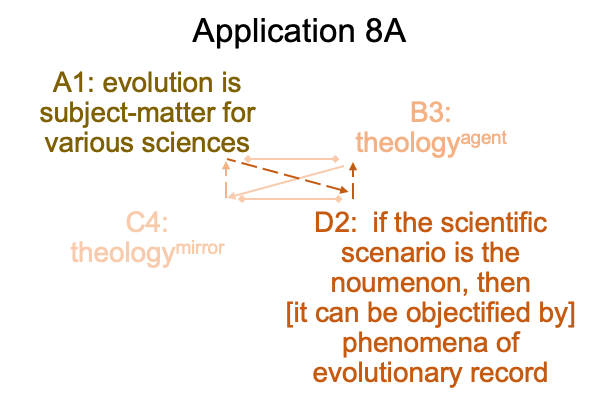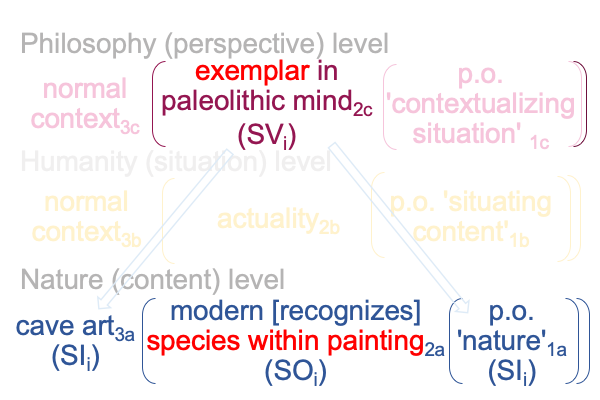0778 What does this day:age scenario do, besides re-describing the noumena and the phenomena of human evolution, as currently elaborated by genetics and natural history?
Shall I consult the optics of Tabaczek’s mirror?
0779 Is the focus is on the six days of creation or the scientific study of evolution?
Well, in a day:age comparison, then it must be the former, no?
Or, must it be the latter?
Perhaps, I should think in terms of the interventional sign. If the sign-object is the thing that I recognize2b, and I recognize the text before2b me as the first chapter of Genesis, then I sense that the sign-vehicle is in the mind of God2c, because only God could have witnessed the evolutionary development of our world.
0780 Say what?
Is the first chapter of Genesis the interventional sign-object2a (SOi) of the evolutionary record as an interventional sign-vehicle2c (SVi)?
Is Genesis One a sign-object (SOi) of the evolutionary record (SVi)?
0781 An affirmative answer suggests that evolution is in the mind of God2c.
And, that is a little confusing.
0782 If advocates of science have their way, then scientific models should overlay the noumenon, the thing itself. Such an overlay buries various metaphysical implications of the noumenon, while simultaneously exploiting human interest in metaphysical implications.
Does that make sense?
If not, then welcome to the modern world.
0783 On top of that, if the scientific scenario is regarded as the noumenon then the noumenon [is objectified by] phenomena of the evolutionary record.
Typically, a noumenon, the thing itself, [cannot be objectified as] its phenomena, its observable and measurable facets.
For example, consider a fork. The noumenon of a fork [cannot be objectified as] the phenomena of a fork, such as its dimensions, composition, tensile strength and so on.
I mention this because in the multicourse meal that the author is presenting, the waiter has taken my fork along with the empty first plate, and just brought me a second fork, for the second plate.
0784 Here is a picture of the optics of Tabaczek’s mirror for this application, so far.

0785 Tabaczek opens chapter five, titled “Aquinas and Evolution”, by claiming that chapter four shows that Thomistic theology is open to evolution.
Unfortunately, this examiner devoured that dish and already digested it by presenting a surprisingly evocative day:age correlation using Aquinas’s key terms.
Fortunately, Tabaczek is in the kitchen, and is not aware of the digestive prowess of some of his readers.
0786 So let me continue.
If a theologyagent constructs a day:age scenario using Aquinas’s key terms embedded in a Peircean category-based nested form, then the resulting work of art is as evocative as any Paleolithic cave painting.
How so?
Take a look at some examples of paleolithic art, such as the unbelievable cave paintings, rendered tens of thousands of years ago at Lascaux.
A modern cannot explicitly abstract these expressions, because these expressions belong to an interventional sign, where an evaluator’s recognition of say, particular species within a cave painting, seems to be a content-level sign object2a and the sign-vehicle resides in the mind of the Paleolithic “artists”2c.
0787 Here is a picture.

0788 What is going on in the minds of the paleolithic people who rendered those cave-paintings?
Do models based on evolutionary psychology account for what is going on?
Or is creativity embedded in having two ways of talking in one language?
The hand-component of hand-speech talk images and indicates its referent, so the referent ontologically precedes the word.
The speech-component of hand-speech talk does not violate this ontological reality. However, it adds a caveat, because the spoken word cannot picture or point to its referent. For spoken words, the word ontologically precedes its referent.
Paleolithic art expresses the referentiality of hand-talk and the ontological sleight-of-hand of speech-talk. Modern viewers recognize the types of creatures portrayed in cave paintings. At the same time, the images, the place, the atmosphere and the flicker of a small fat-burning flame speak to the viewer. They say, “Hear our song!”
